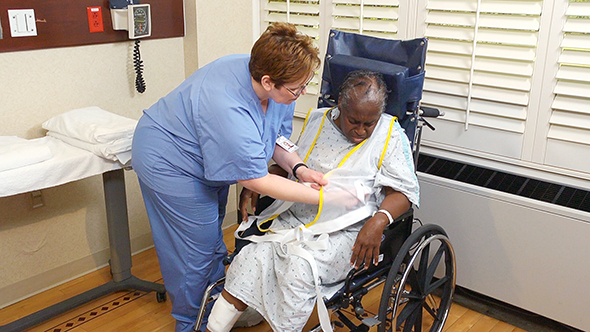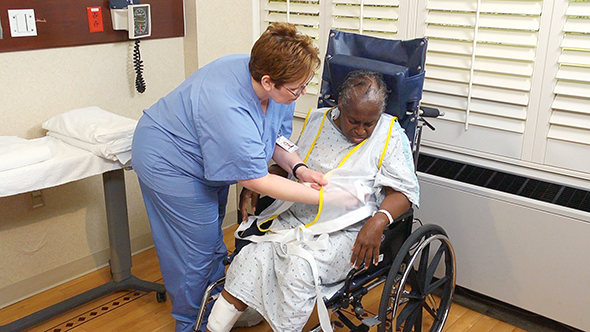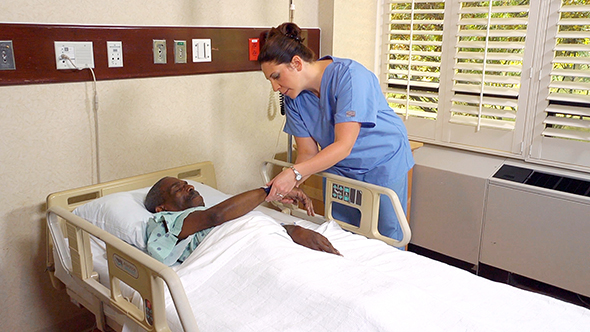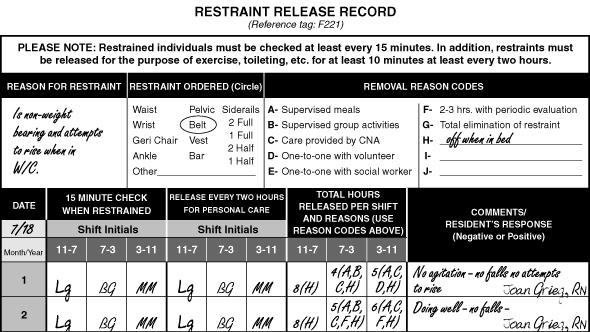Infection Control and Safety Measures
Select a Skill:
- » Performing Hand Hygiene
- » Using Personal Protective Equipment
- » Using Restraint Alternatives
- » Applying Restraints Safely
Take the Review Test:

Purpose

- Restraints are used only when needed to treat a medical symptom or for the immediate physical safety of the person or others.
- Restraints may be used only when less restrictive measures fail to protect the person or others.
- They must be discontinued at the earliest possible time.
Equipment
Roll cursor over items to see labels. For the purposes of clearly depicting the equipment, a barrier is not shown in this photo. When providing care, a barrier should always be placed on the surface before placing the equipment.

Wheelchair with neck rest
Vest restraint
Jacket restraint
Belt restraint
Mitt restraints
Elbow padding
Wrist restraints
Bed rail padding
Delegation
Follow delegation guidelines. Before applying a restraint, obtain this information from the nurse and care plan:
- Why the doctor ordered the restraint
- What type and size to use
- Where to apply the restraint
- How to safely apply the restraint
- How to correctly position the person
- What bony areas to pad and how to pad them
- If bed rail covers or gap protectors are needed
- If bed rails are up or down
- What special equipment is needed
- If the person needs to be checked more often than every 15 minutes
- When to apply and release the restraint
- What observations to report and record
- When to report observations
- What patient or resident concerns to report at once
Preparation

- Ensure that the person (or his or her legal representative) has given consent before using a restraint.
- Check the medical provider’s or doctor’s order before applying a restraint.
- Observe quality-of-life measures.
- Review the information under Delegation and Safety and Comfort.
- Collect the equipment.
- Practice hand hygiene.
- Identify the person. Check the ID bracelet against the assignment sheet. Also call the person by name.
- Provide for privacy.
Safety

- Always follow the manufacturer’s instructions.
- Never use force to apply a restraint. Ask a co-worker to help if a person is confused and agitated. Report problems to the nurse at once.
- Check the person at least every 15 minutes as instructed by the nurse and the care plan. Make sure the signal light is within reach. Ask the person to use the signal light at the first sign of problems or discomfort.
- Never use a restraint as a seat belt in a car or other vehicle.
- Observe a person with mitt restraints closely to make sure that he or she does not:
- Use the teeth to remove or damage the device.
- Ingest any mitt material.
- Fall when walking about. Practice safety measures to prevent falls.
- Do not use a belt, vest, or jacket restraint if the person has a colostomy or ileostomy, a gastrostomy tube, drainage tubes after surgery, incisions, chronic obstructive pulmonary disease, or devices to monitor vital signs.
- If a belt, vest, or jacket restraint is ordered, remind the nurse of the person’s condition and needs. Also monitor to make sure the person cannot become suspended or entrapped by sliding forward or down in the chair or bed or by falling off the chair or mattress.
Comfort
- Position the person in good alignment before applying a restraint.
- Make sure that the restraint is snug.
- Make sure the person can reach needed items—the signal light, water, tissues, phone, bed controls, and so on.
Procedure Video
Audio Description: OFFFollow-up Care

- Position the patient as the nurse directs.
- Provide for comfort.
- Place the signal light within the person's reach.
- Raise or lower the bed rails. Follow the care plan and manufacturer's instructions.
- Unscreen the person.
- Complete a safety check of the room.
- Practice hand hygiene.
- Check the person and the restraint at least every 15 minutes. For wrist, mitt, or elbow restraints: check the pulse, color, and temperature of the restrained parts. For a vest, jacket, or belt restraint: check the person's breathing. Make sure the restraint is properly positioned in the front and back.
- Do the following at least every 2 hours for at least 10 minutes: Remove or release the restraint. Do not leave the person alone while the restraint is off. Measure vital signs. Reposition the person. Meet food, fluid, hygiene, and elimination needs. Give skin care. Perform range-of-motion exercises or help the person walk. (Follow the care plan.) Provide for physical and emotional comfort. Reapply the restraints.
Reporting/Recording
- Call for the nurse at once if the person is not breathing or is having problems breathing.
- Report and record your observations and the care given.
Review Questions
Select the best answer.
1. When applying a restraint, which safety measure should you take?
 Adjust the straps so that the restraint is very tight.
Adjust the straps so that the restraint is very tight. Ensure that the quick-release tie is within the person’s reach.
Ensure that the quick-release tie is within the person’s reach. Follow the manufacturer’s instructions for applying the restraint.
Follow the manufacturer’s instructions for applying the restraint. Use a square knot to secure the restraint straps to a chair or bed.
Use a square knot to secure the restraint straps to a chair or bed.
Select the best answer.
2. When caring for a person with a restraint, which action is important?
 Check the person every 60 minutes during restraint use
Check the person every 60 minutes during restraint use Remove the restraints for 15 to 20 minutes at least every 8 hours
Remove the restraints for 15 to 20 minutes at least every 8 hours Check the pulse, color, and temperature of the body parts in a wrist restraint
Check the pulse, color, and temperature of the body parts in a wrist restraint Notify the nurse at the end of the shift if the person reports problems breathing
Notify the nurse at the end of the shift if the person reports problems breathing
Select the best answer.
3. What is the correct way to apply a belt restraint?
 Ensure the belt is snug by placing one finger between the restraint and the person
Ensure the belt is snug by placing one finger between the restraint and the person Place the straps at a 90-degree angle between the wheelchair seat and sides
Place the straps at a 90-degree angle between the wheelchair seat and sides Secure the restraint straps to the wheels for a person in a wheelchair
Secure the restraint straps to the wheels for a person in a wheelchair Remove wrinkles or creases from the front and back of the restraint
Remove wrinkles or creases from the front and back of the restraint
Select the best answer.
4. When applying a vest restraint, where should the “V” neck be positioned?
Select the best answer.
5. Which type of restraint increases the risk of falls?
You have completed the Review Questions for this skill. To take the Review again select the Start Over button. To proceed to another skill select from the dropdown menu. Select the Home or Back button to proceed to the next section.

